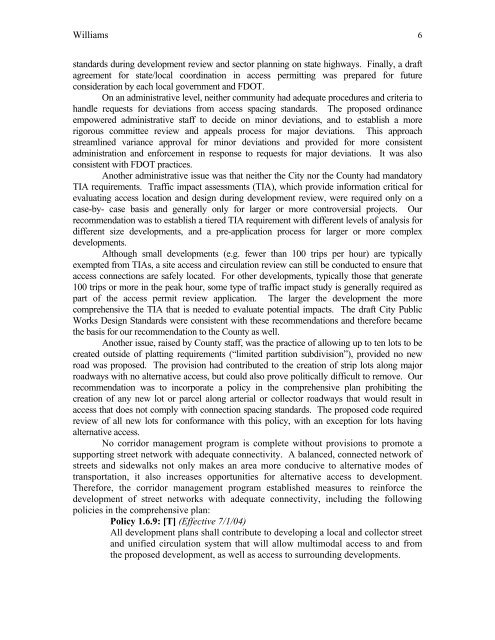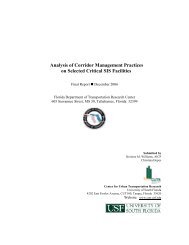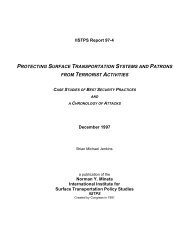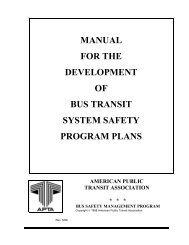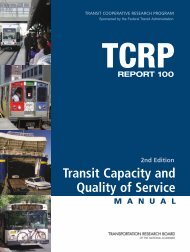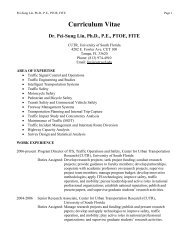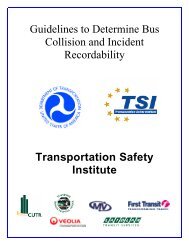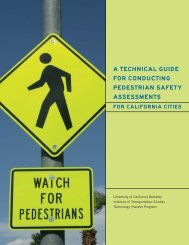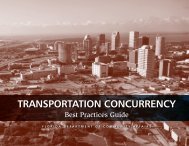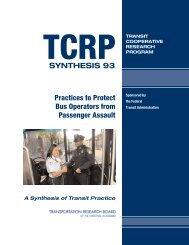Tallahassee-Leon County Corridor Management Program
Tallahassee-Leon County Corridor Management Program
Tallahassee-Leon County Corridor Management Program
You also want an ePaper? Increase the reach of your titles
YUMPU automatically turns print PDFs into web optimized ePapers that Google loves.
Williams 6standards during development review and sector planning on state highways. Finally, a draftagreement for state/local coordination in access permitting was prepared for futureconsideration by each local government and FDOT.On an administrative level, neither community had adequate procedures and criteria tohandle requests for deviations from access spacing standards. The proposed ordinanceempowered administrative staff to decide on minor deviations, and to establish a morerigorous committee review and appeals process for major deviations. This approachstreamlined variance approval for minor deviations and provided for more consistentadministration and enforcement in response to requests for major deviations. It was alsoconsistent with FDOT practices.Another administrative issue was that neither the City nor the <strong>County</strong> had mandatoryTIA requirements. Traffic impact assessments (TIA), which provide information critical forevaluating access location and design during development review, were required only on acase-by- case basis and generally only for larger or more controversial projects. Ourrecommendation was to establish a tiered TIA requirement with different levels of analysis fordifferent size developments, and a pre-application process for larger or more complexdevelopments.Although small developments (e.g. fewer than 100 trips per hour) are typicallyexempted from TIAs, a site access and circulation review can still be conducted to ensure thataccess connections are safely located. For other developments, typically those that generate100 trips or more in the peak hour, some type of traffic impact study is generally required aspart of the access permit review application. The larger the development the morecomprehensive the TIA that is needed to evaluate potential impacts. The draft City PublicWorks Design Standards were consistent with these recommendations and therefore becamethe basis for our recommendation to the <strong>County</strong> as well.Another issue, raised by <strong>County</strong> staff, was the practice of allowing up to ten lots to becreated outside of platting requirements (“limited partition subdivision”), provided no newroad was proposed. The provision had contributed to the creation of strip lots along majorroadways with no alternative access, but could also prove politically difficult to remove. Ourrecommendation was to incorporate a policy in the comprehensive plan prohibiting thecreation of any new lot or parcel along arterial or collector roadways that would result inaccess that does not comply with connection spacing standards. The proposed code requiredreview of all new lots for conformance with this policy, with an exception for lots havingalternative access.No corridor management program is complete without provisions to promote asupporting street network with adequate connectivity. A balanced, connected network ofstreets and sidewalks not only makes an area more conducive to alternative modes oftransportation, it also increases opportunities for alternative access to development.Therefore, the corridor management program established measures to reinforce thedevelopment of street networks with adequate connectivity, including the followingpolicies in the comprehensive plan:Policy 1.6.9: [T] (Effective 7/1/04)All development plans shall contribute to developing a local and collector streetand unified circulation system that will allow multimodal access to and fromthe proposed development, as well as access to surrounding developments.


